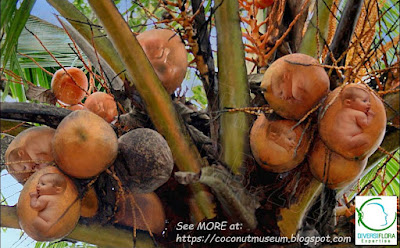©R. Bourdeix, 2021, section CF
For illustrating this section, we can produce on request a dozen of large size HD poster (up to 180x100 cm in size). Some of these posters will have to be adapted to each country, on a case-by-case basis, in order to prominently feature locally produced coconut products and concepts. It is also possible to buy or rent items from the personal collection of Dr R. Bourdeix.
- CFR. Religious uses - Usages religieux
- CFL. Legends - Légendes
- CFE. Coconut game - Jeux de coco
- CFM. Musical coconut - Musique
- CFD. Dancing coconut - Danse
- CFG. Places named coconut - Géographie
- CFI. Islands - Îles et cocotier
- CFA. Animals and coconut - Animaux et cocotier
- CFX. Sexy coconut! - Sexe et cocotier!
- CFO. Other cultural uses - Autres usages culturels
Why the vine, giving grapes and wine? Indeed, from a botanical point of view, these two plants, the vine and the coconut palm, are not alike. On the other hand, the coconut and the vine have points in common regarding their relationship with man. Since the origin of man, these two plants have marked mythologies and religions, food traditions and practices, geography and the economy. Both plants contribute, over time, to the development of complex social organizations and varied arts of living.
 |
| A coconut church door in Sri Lanka |
The oldest documents quoting the coconut palm go back to 1650 before JC.
A long time ago, in the India area of Punjab, the babies were born neither in the pinks, nor in
cabbages, but in the coconut. At this time, it was extremely easy to get a new baby:
you just had to find a coconut palm, to harvest a coconut, to open this coconut,
and to get a new baby inside.
In fact, it was so easy to have a baby that parents
neglected them. As soon as a baby started to cry or fell sick, the parents
threw it in a corner, and went to the coconut palm to gather a new baby. God
was afflicted by seeing all these miserable and forsaken children who trailed
on the ground and ended up dying. Then, it decided: “it is necessary that I find
a means so that the mothers take more care of their offspring”. So, since this
time, babies do not born anymore from the coconuts, and things are less easy.
Coconut has a special place in many cultures. In the Hindu culture of India, believed to be an auspicious fruit and used in many rituals. Coconut is offered to deities in Hindu temples across the globe. Many holy events and celebrations are inaugurated with breaking of coconuts. It is a symbol of prosperity and believed to welcome Lakshmi, the goddess of wealth for Hindus, and has also a strong link with Ganesha, the god of Luck with an elephant head.
To quote a type of symbiosis between human beings and plants, the Sinhalese claim that the coconut tree dries up as soon as it is out of reach of a human voice. In Polynesia, people say that “the coconut palm only germinates where it hears the sea or of the human voices”. This is the great power of poetry, because in reality it is probably not the voice that the coconut tree needs, but rather the organic and liquid waste generated by human activity and the presence of the sea!



